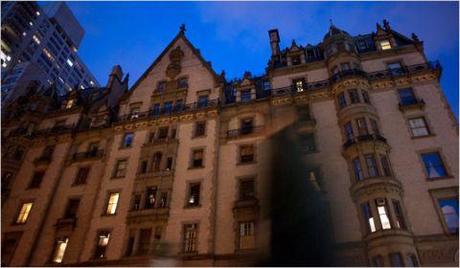
EDWARD CLARK'S "FOLLY"
The address, One West 72nd Street, may not register with many who live outside the city of New York, but the name of the building at the corner of 72nd Street and Central Park West is more familiar. The Dakota, a famed luxury co-op on the Upper West Side, has been home to many high profile luminaries, served as the setting for one of Roman Polanski's best known films, and was the site of an infamous murder in 1980
Posh apartment houses designed expressly for the well-heeled were rare in New York in 1880, when construction of the Dakota began. Apartment housing at that time and place was mainly associated with tenements and lower class living, but in the late 1860s the Stuyvesant building opened. It attracted the reasonably well-to-do in droves and soon more such residences were in the works.
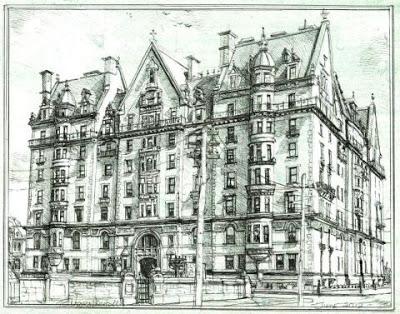
The Dakota by Richard Britell
The lot on which the Dakota would stand was in an area that was then largely undeveloped - both far north and west of what was considered the city's boundaries. And though the building would face Central Park, that region of the park had yet to be landscaped or developed. In fact, the street that was to become Central Park West was still but a dirt road. Astonishingly, all 65 of the Dakota's 4- to 20-room apartments were rented by the time its doors opened in late 1884; from that day until the stock market crash of 1929, there was not even one vacancy in the building.
Dakota railing detail
Edward Clark, an attorney who made a great fortune as partner to Isaac M. Singer in the Singer Sewing Machine Company, conceived and built the Dakota. He hired architect Henry Hardenburgh (the Waldorf-Astoria, the Plaza Hotel), then early in his career at age 32, to design the building. The project would establish Hardenburgh's reputation. Massive and extravagant, the Dakota's exteriorwas an eclectic interpretation of German Renaissance style while the interior reflected French architectural influences then popular in New York. In his 1970 illustrated novel Time and Again, Jack Finney wrote of the Dakota's "pale yellow brick handsomely trimmed in chocolate-colored stone," of its roof "like a miniature town...of gables, turrets, pyramids, towers, peaks" shingled in copper-trimmed slate and "peppered with uncountable windows, dormer and flush, square, round, and rectangular." Sadly, Edward Clark would not live to see the completion of the Dakota and his own sumptuous apartment in the building would be bestowed upon his 12-year-old grandson and heir.
Leonard Bernstein's piano in his Dakota apartment
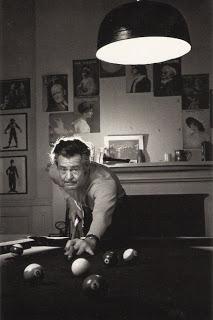
Robert Ryan in his home at the Dakota (later
purchased by John Lennon and Yoko Ono)
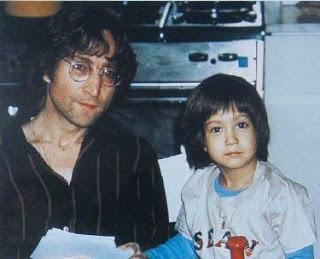
John and Sean Lennon in their Dakota kitchen
As with many structures of gothic appearance, the Dakota weathered rumors of supernatural incidents and ghost stories. Movie critic and Dakota resident Rex Reed recalled that a doorman warned him early on to expect to see Boris Karloff's ghost. Strange and unexplained events were witnessed below ground, in the basement and, for a brief period, a so-called "Phantom of the Dakota" vandalized the building and spooked its inhabitants. But it was only with the release of Roman Polanski's Rosemary's Baby (1968), set and partially shot at the Dakota, that the building's reputation for quirkiness and opulence took on a decidedly dark facet. With the deadly 1980 shooting of John Lennon at the building's front gate, the incomprehensible and horrifying became real.

Long-time Dakota resident Lauren Bacall at home in 2011
ROSEMARY'S BABY
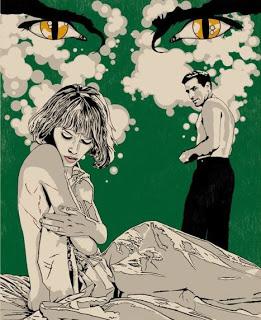
When Roman Polanski walked into the office of newly appointed Paramount Pictures production head Bob Evans for the first time in 1967, he thought he was there to discuss directing Downhill Racer, the project Evans touted when he asked for the meeting. Instead, Evans quickly admitted that, knowing Polanski loved to ski, he'd used the project, the story of a U.S. Olympic team skier, as a lure. What Evans really wanted to talk with Polanski about was directing a film adaptation of Ira Levin's soon-to-be-published horror thriller, Rosemary's Baby. Evans gave him the printer's galley proofs to take home and look over. In a sitting, Polanski read through Levin's chilling tale of a contemporary Manhattan couple who move into a fabled apartment building - with terrifying consequences. He quickly agreed to direct.

Bob Evans and Roman Polanski
Why was Evans intent upon hiring Polanski to direct Rosemary's Baby? William Castle, producer/director of low-budget horror movies, had optioned the screen rights for the book. Castle, who had an exclusive contract with the studio, hoped to direct the film himself. But Evans wasn't interested in making the grade "B" genre fare Castle turned out, pictures like The Tingler (1959), 13 Ghosts (1960) and Strait-Jacket (1964). Evans, destined to become a legendary figure in the New Hollywood era, saw Rosemary's Baby as a director's film and his interest was piqued by the Polish director of what he called "three really offbeat thrillers," Knife in the Water (1962), Repulsion (1965) and Cul-de-sac (1966). Knife in the Water, a taut psychological drama that marked Polanski's feature film debut, brought an Oscar nomination for Best Foreign Language Film and international acclaim. Repulsion starred Catherine Deneuve and Cul-de-sac starred her sister, Francoise Dorleac; both were moody, surreal films that won international awards. Evans believed Polanski's iconoclastic vision might conjure something special and unusual out of Levin's sly, dark fiction and was able to convince Castle to confine himself to the role of producer. Polanski thought Levin's book a "well-constructed thriller," cinematic in nature, and immediately began work on the script, writing from dawn to dark for days on end.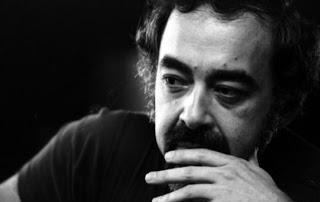
Ira Levin
In the meantime, Rosemary's Baby was published and became a #1 best-seller. The National Observer called the book "the best chiller to come down the gooseflesh trail in many a moonless night." Even the New York Times review was a rave and anticipation for the film adaptation ran high
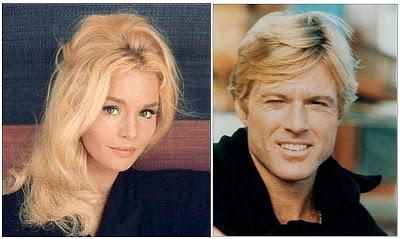
Tuesday Weld and Robert Redford
Polanski originally planned to cast the lead roles with actors who possessed the All-American good looks and energy depicted in Levin's book, and favored Tuesday Weld for Rosemary and Robert Redford as her husband, Guy. When Bob Evans suggested Mia Farrow, the director at first thought her too waif-like and ethereal for the title role. But after meeting and discussing the role with her he hired her without so much as a screen test. Robert Redford became unavailable and Warren Beatty turned down the role of Guy, so Polanski turned to John Cassavetes, an intense, charismatic actor who was also making a name for himself as an independent filmmaker. The hand-picked supporting cast included Hollywood troupers Ralph Bellamy, Patsy Kelly and Elisha Cook, Jr., as well as stage and screen veterans Maurice Evans, Sidney Blackmer and Ruth Gordon. Uncredited in the role Polanski characterized as "the real star of the picture," the Bramford apartment building, was the Dakota. Exteriors were shot on-site and Richard Sylbert, Polanski's production designer, scrupulously recreated the Dakota's interiors (off-limits to movie-makers) in Hollywood. Rosemary's Baby would begin and end with aerial views of the imposing structure.
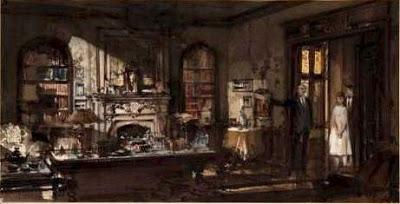
"Bramford"/Dakota interior sketch by Richard Sylbert
Production was underway for only a week when Charles Bluhdorn, Paramount's new owner, began to have second thoughts about Polanski, whose focus on artistic values and fine details he viewed as unreasonable perfectionism. One day while on the studio lot Polanski ran into filmmaking legend Otto Preminger. Dejected, he told the older director there was talk he was going to be replaced on Rosemary's Baby. Preminger asked if the studio was happy with the rushes and when Polanski told him it was, he said: "Roman, remember this: You can go over budget as much as you like, provided the rushes are good. They only replace a director when the dailies are lousy." What Bob Evans saw in Polanski's dailies was an "ominous sense of fright" - and it thrilled him; he told Paramount, "If he goes, I go." Both stayed.
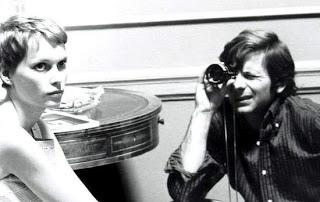
Mia Farrow and Roman Polanski on the set
Polanski was determined to recreate the exact time frame in which the story was set, mid-1965 to mid-1966, just two years before the film was made. Trends had shifted inthat brief period;by 1968 styles had begun to swing from the influence of all-things-English ushered in with "the British Invasion" to a more bohemian sensibility reflecting the "flower power"/"hippie" phenomenon. His insistence on authentic detail drove costume designer Anthea Sylbert's meticulous replication of mid-'60s fashion. She captured the look of the moment with Rosemary's Mod-era shifts, mini-dresses and attire like a red chiffon pants suit to be worn on a romantic evening at home. Other time-specific touches include Rosemary's decision to have her pageboy tresses snipped into a short Vidal Sassoon cut, Rosemary relaxing on the sofa with Sammy Davis, Jr.'s book Yes, I Can (a 1965 best-seller), a glimpse on TV of the Pope's October 1965 visit to New York, and Timemagazine's famous "Is God Dead?" issue (April 8, 1966) conspicuous among the reading material in her doctor's waiting room.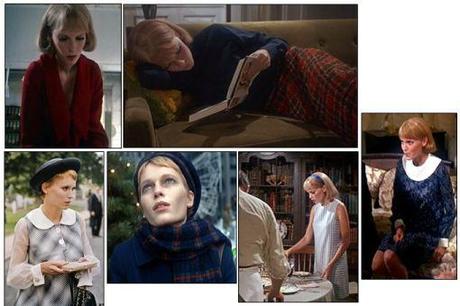
Costumes by Anthea Sylbert
Polanski later said the story line of Rosemary's Baby had posed one problem for him, it conflicted with his own worldview. He didn't believe in Satan. So he decided, "for credibility's sake," to add an element of ambiguity suggesting the possibility that Rosemary's imagination was the source of her fears. With careful camera placement and the use of special lenses,Polanski presented the story through Rosemary's eyes. Drawn into Rosemary's point of view, the audience easily relates to her confusion, feelings of vulnerability and increasing fright. Like Rosemary, the viewer is aware of lurking danger but wavers between believing what she begins to suspect is happening or accepting the rational explanations offered by others.
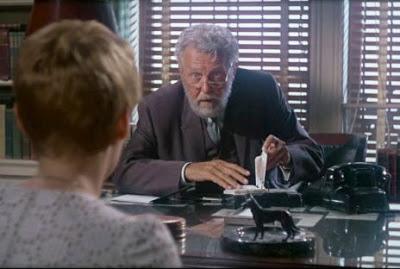
Mia Farrow and Ralph Bellamy (Dr. Saperstein)
While Rosemary remains constant as a naive and mostly defenseless young wife, those who inhabit her shrinking world are more enigmatic - from her ambitious actor husband and intrusive neighbors to her wise and kindly old doctor. Ironically, some of the characters who are revealed to be most wicked are also the most comically grotesque. In keeping with Polanski's brand of humor, the film is laced with darkly comic moments:
- Rosemary and Guy dine at the home of her friend Hutch (Maurice Evans). As Hutch carves a lamb at table, he relates the ghoulish history of the Bramford - which included a pair of sisters who, it was later charged, devoured children...
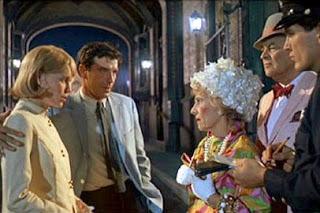
Rosemary and Guy meet The Castavets
- The aftermath of a shocking suicide introduces the Castevets, Minnie (Ruth Gordon) and Roman (Sidney Blackmer), a pair of elderly oddballs who arrive on scene decked out as if fresh from the vaudeville stage
- Rosemary sees her baby for the first time and, uncomprehending, shrieks, "What have you done to its eyes?" Roman Castevet crows happily, "He has his father's eyes!"
Considered a genre-transcending classic today, Rosemary's Baby remains a landmark of modern horror, as capable of jangling nervesand inducing chills as it was in its infancy 45 years ago.
Rosemary's Baby is available on Blu-Ray and DVD from the Criterion Collection. This special edition contains many extras, including: a documentary featuring Polanski, Mia Farrow and Bob Evans; an interview with Ira Levin; a documentary on the life and work of composer Krzysztof Komeda (who died 10 months after the film was released) and other special features.
~ Notes:
Life at the Dakota by Stephen Birmingham, Syracuse University Press (1979/1996)
Roman by Polanksi, William Morrow & Co. (1984)
The Kid Stays in the Picture by Robert Evans, Hyperion (1994)

